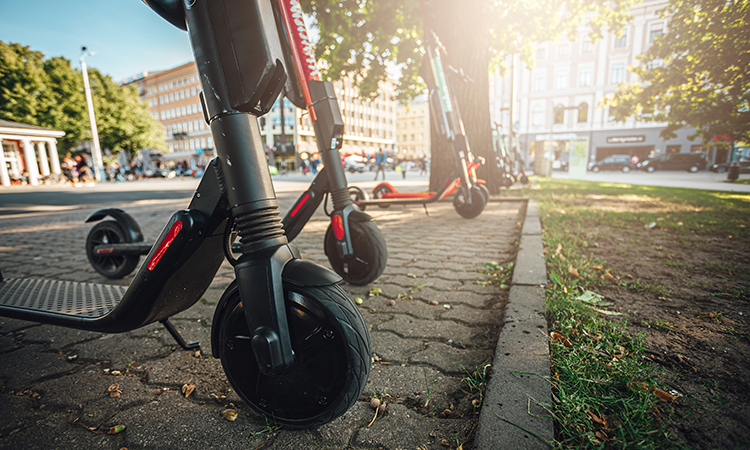Regulating micro-mobility based on incomplete data sets?
- Like
- Digg
- Del
- Tumblr
- VKontakte
- Buffer
- Love This
- Odnoklassniki
- Meneame
- Blogger
- Amazon
- Yahoo Mail
- Gmail
- AOL
- Newsvine
- HackerNews
- Evernote
- MySpace
- Mail.ru
- Viadeo
- Line
- Comments
- Yummly
- SMS
- Viber
- Telegram
- Subscribe
- Skype
- Facebook Messenger
- Kakao
- LiveJournal
- Yammer
- Edgar
- Fintel
- Mix
- Instapaper
- Copy Link
Posted: 29 March 2023 | Sebastian Schlebusch - Dott, Welmoed Neijmeijer - Bolt | No comments yet
Welmoed Neijmeijer, Co-Chair of Micro-Mobility for Europe and Head of Public Policy – Micromobility & Carsharing at Bolt, and Sebastian Schlebusch, Head of Market Development at Dott, share exclusive insight into MMfE’s recent publication of aggregated micro-mobility incident data, which aims to put the data into a relative context and provide evidence to policy discussions, with the end goal of better regulating micro-mobility through the use of complete, standardised and comparable data.


Within the basket of mobility options, micro-mobility is among the most recent and innovative options enabling citizens to move around cities. In some cases, regulators are introducing rules for this new service based on incomplete or outdated data; in particular, regarding incidents. There are different reasons that lead to this unavailability of data. Firstly, there is no standardised approach to reporting accident data, neither on a European Union (EU) level nor on a national level. Secondly, where data is recorded, it is done using different methodologies, which results in data being incomparable. Hence, there was a need for the industry to be proactive by aggregating the data of six operators across Europe.
Micro-mobility can be a real asset to cities in fighting climate change, but benefits like reducing emissions are not always taken into account”
Micro-mobility can be a real asset to cities in fighting climate change, but benefits like reducing emissions are not always taken into account as the safety of innovative mobility services, such as micro-mobility, often dominate media coverage, with much less attention given to its performance compared to other modes, or to the societal benefits that shared micro-mobility services create.
Analysing our findings
In an industry-wide effort, Micro-Mobility for Europe (MMfE) has aggregated1 2021 e-scooter incident data of its six founding members – Bird, Bolt, Dott, Lime, TIER Mobility and Voi Technology. MMfE is the association of shared micro-mobility providers and, in 2023, the founding members were joined by Hopp and Superpedestrian. The data is based on more than 240 million trips, with 461 million kilometres travelled across 29 European countries. Generally, due to the lack of a European standardised incident framework, there is a lack of consistent and comparable data across modes and severity levels.
Sebastian Schlebusch, Head of Market Development at Dott, who leads the initiative for MMfE, said: “We are always confronted with negative headlines every time there is an accident. And the rise of the absolute number of accidents is quite natural, as it derives from the increasing amount of trips taken. Putting this into a relative context was one of the key motivations for us to launch this initiative.”
The data reveals that the risk of shared e-scooter incidents fell by 60% compared to 2019, while the fatality risk was 0.015 per one million kilometres ridden. Welmoed Neijmeijer, one of the Co-Chairs of MMfE and Head of Public Policy – Micromobility and Carsharing at Bolt, concludes that: “It is great to see that there was a significant downward trend, especially taking into account the increase of the fleet sizes at that time and the increasing number of trips.”
Data shows that shared e-scooters are much safer than private ones. The estimated risk of fatal incidents on private e-scooters in Germany is 0.030 fatal incidents per million kilometre. In France, only one out of 24 fatal micro-mobility incidents were recorded on a shared e-scooter, with the other 23 either on private e-scooters or other micro-mobility devices. In the UK, private e-scooters are reported to be involved in 82% of all e-scooter casualty collisions. This shows that there is a significant difference between the safety of private and shared e-scooters, as the fatality risk of private scooters is twice as high compared to shared scooters.
In comparison to other modes, industry data shows that the fatality risk is comparable to bicycles and is 20 times lower than mopeds.


Utilising data to inform policy discussions
With this first-of-its-kind publication, MMfE aims to contribute to the public debate and provide evidence to policy discussions. Especially for relatively new mobility services, it is of utmost importance that decision-makers base decisions for operation on empirical evidence to embrace the opportunities offered by shared micro-mobility, such as reducing car dependency, decreasing air and noise pollution, tackling congestion and complementing public transport.
With this first-of-its-kind publication, MMfE aims to contribute to the public debate and provide evidence to policy discussions”
MMfE is committed to ensuring the highest level of safety, from vehicle conception, rider education and safety solutions. By doing this, MMfE seeks to contribute to the European Union’s Vision Zero.
In a joint letter2, the Clean Cities Campaign – hosted by Transport & Environment – the European Parliament’s Urban Intergroup and Micro-Mobility for Europe emphasised that micro‑mobility plays an increasingly important role in achieving cities’ sustainable transportation goals and is one solution to cities’ persistent challenges, such as reducing traffic congestion and air and noise pollution. Moreover, the signatories called on cities to prioritise the safety of vulnerable road users – such as pedestrians, cyclists and scooter riders – by investing in infrastructure that creates safer spaces on streets and reduces space from cars.
In this context, Barbara Stoll, Director of the Clean Cities Campaign, said: “Shared micro-mobility can be an essential part of reducing car use in our cities. It helps to close gaps in public transport networks, provides a reliable way to get from A to B, even at rush hour, and reduces the number of parking places. Of course, micro-mobility needs to be properly regulated to make good use of scarce public space and to guarantee road safety. Developing smart regulations with civil society and operators is the way to go; de facto bans would only deprive citizens of an important mobility option whilst doing nothing to tackle the main problem in cities – polluting cars.”
Recommendations
Based on the findings, a range of recommendations to policymakers and public authorities were identified, which consider the themes of Infrastructure, Reporting Standards, Definition of Vulnerable Road Users (VRU) and Enforcement. These recommendations contribute to an uptake of micro-mobility solutions which results in societal benefits for cities and citizens. These benefits include reducing traffic congestion, combatting air and noise pollution and strengthening urban mobility systems.
Safer infrastructure
Firstly, investments in safe infrastructure are an enabler to encourage the use of micro-mobility. In addition, research has shown that protected bike lanes reduce the risk of injuries and prevent riders from riding on the pavement, which is often done as a consequence of a lack of safe infrastructure.
Harmonising incident report standards
Secondly, as MMfE’s incident data aggregation has shown, there is a need to harmonise incident report standards across Europe. Currently, EU Member States use varying definitions of injury severity levels, which has an impact on the comparability of data. Also, local authorities lack a standardised way of collecting and reporting incident data, often without distinction between private and shared e-scooters.
Re-defining VRUs
Thirdly, the concept and definition of Vulnerable Road Users needs to be revised, as this group does not only cover pedestrians and cyclists, but also users of e-scooters and e-bikes, all of which are significantly more vulnerable than persons in cars.
Safety awareness
Finally, safe behaviour of all traffic participants requires societal awareness of collective safety. While MMfE members are investing in education, there is a need for authorities to ensure the enforcement of rules.
What’s next?
Taking industry efforts to another level, operators are looking towards establishing an MMfE-wide safety advisory board, to exchange best practices and set common goals”
The first publication of aggregated incident data has received attention across different actors, including political and industry stakeholders. During an event dedicated to micro-mobility organised in the European Parliament, the publication of the data was announced, which was welcomed by Members of the European Parliament.
With shared micro-mobility becoming ever more popular, operators are committed to working towards aggregating incident data of e-scooters and e-bikes for 2022. Taking industry efforts to another level, operators are looking towards establishing an MMfE-wide safety advisory board, to exchange best practices and set common goals.
References
- https://micromobilityforeurope.eu/industry-alliance-publishes-first-of-its-kind-incident-data-involving-shared-e-scooters/
- https://mcusercontent.com/6df6fe5707bd75915c179dcc1/files/2fc887e6-d4e4-e80c-da1e-0fb42dff4e2a/Joint_Letter_How_Cities_Benefit_From_Micro_Mobility_15_Nov_2022.pdf




Related topics
Air Quality, Micro-mobility, On-Demand Transport, Passenger Experience, Sustainable Urban Transport, Traffic Management, Transport Governance & Policy, Vehicle & Passenger Safety
Issue
Issue 1 2023
Related modes
Bikes & Scooters
Related organisations
Bird, Bolt, Clean Cities Campaign, Dott, European Parliament, European Union (EU), Hopp, Lime, Micromobility for Europe (MMfE), Superpedestrian, TIER Mobility, Transport & Environment, Voi Technology
Related people
Barbara Stoll, Sebastian Schlebusch, Welmoed Neijmeijer








